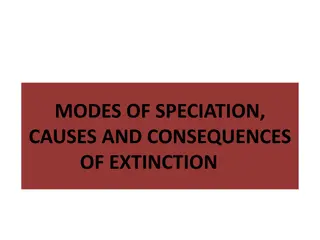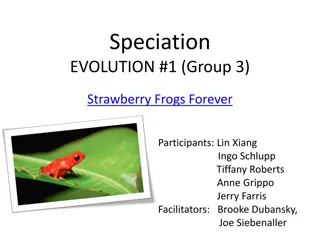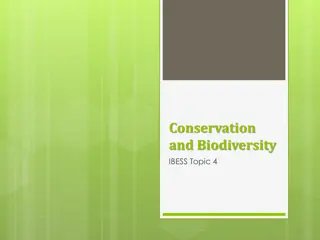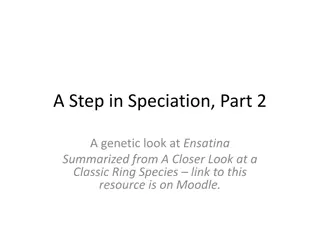Sympatric Speciation: Evolution Without Geographic Isolation
Sympatric speciation involves the evolution of reproductive isolation without geographical barriers, leading to the splitting of an ancestral species into reproductively isolated groups within the same area. Possible reasons for reproductive isolation include disruptive selection, competition for resources, and sexual selection. Characteristics, mechanisms, and examples of sympatric speciation are explored, highlighting the role of factors like genetic divergence, ecological isolation, disruptive selection, hybridization, and changes in chromosome number. The case of Rhagoletis pomonella illustrates how divergence in habitat preference can drive reproductive isolation in sympatric populations.
Download Presentation

Please find below an Image/Link to download the presentation.
The content on the website is provided AS IS for your information and personal use only. It may not be sold, licensed, or shared on other websites without obtaining consent from the author.If you encounter any issues during the download, it is possible that the publisher has removed the file from their server.
You are allowed to download the files provided on this website for personal or commercial use, subject to the condition that they are used lawfully. All files are the property of their respective owners.
The content on the website is provided AS IS for your information and personal use only. It may not be sold, licensed, or shared on other websites without obtaining consent from the author.
E N D
Presentation Transcript
Mode of speciation continued . (Unit 10, species concept
Sympatric speciation Definition Sympatric speciation, (from the Greek same place ) involves the splitting of an ancestral species into two or more reproductively isolated groups without geographical isolation of those groups. According to Mayr, 1942 Sympatric speciation is the evolution of reproductive isolation without geographical isolations.
Possible reason for reproductive isolation Disruptive selection (This is one of the mode of natural selection that favours those individuals of a population which have phenotype extremes for a particular characters). Competition of same resources. Sexual selection.
Characteristics of sympatric speciation It occurs in same geographical area. There is no physical barrier as present in case of allopatric speciation. Sympatric speciation Vs Allopatric Vs Parapatric speciation Sympatric involves evolution of reproductive isolation without geographical isolation. Allopatric means speciation through geographical barriers like mountain, rivers, dessert etc. Parapatric speciation involves origin of species when there is no completely geographical barrier. Restricted gene flow occurs.
Mechanism of sympatric speciation It occurs by genetic divergence in the gene pools 1. Ecological isolation 2. Disruptive selection 3. Hybridisation 4. Change in chromosome number/structure
Example of sympatric speciation Divergence of an insect maggot fly called Rhagoletis pomonella. This insect specialised on hawthorn fruits (Native). But on introduction of another plant called apple tree in North America now maggot fly shifted to apple tree more preferentially. So it led to reproductive isolation by 1. Divergent mate timing 2. Habitat choice.
Change in chromosome number New species arises in a sympatric population through change in chromosome number. The reason for development of polyploidy in a species may be due to non-disjunction of chromosomes duting cell division (mitosis/meiosis). 1. Autopolyploidy and 2. Allopolyploidy Tetraploid hybrid
Sympatric speciation by Hybridisation The combined effect of hybridization and change in chromosome number may result into speciation. Speciation of Heliconius butterflies due to Hybridisation is an example. Novel gene combinations with novel morphological features due to hybridization lead to origin of species.
References 1. Bolnick and Fitzpatrick (2007). Sympatric Speciation: Models and Empirical Evidence. Annu. Rev. Ecol. Evol. Syst. 2007. 38:459 87. 2. Jesu s Mava rez, Camilo A. Salazar, Eldredge Bermingham, Christian Salcedo, Chris D. Jiggins & Mauricio Linares. Speciation by hybridization in Heliconius butterflies. Vol 441|15 June 2006. 3. Jerry A. Coyne. Sympatric speciation .Current Biology Vol 17 No 18.























